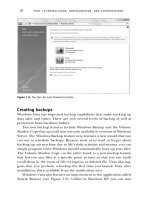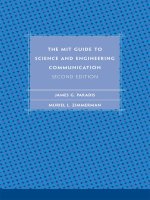lego mindstorms the unofficial guide to robots jonathan b knudsen pdf
Bạn đang xem bản rút gọn của tài liệu. Xem và tải ngay bản đầy đủ của tài liệu tại đây (3.93 MB, 266 trang )
iii
The Unofficial Guide to LEGO® MINDSTORMS™ Robots
Jonathan B. Knudsen
O’REILLY
Beijing • Cambridge • Farnham • Köln • Paris • Sebastopol • Taipei • Tokyo
iv
The Unofficial Guide to LEGO® MINDSTORMS™ Robots
by Jonathan B. Knudsen
Copyright: © 1999 O'Reilly & Associates, Inc. All rights reserved.
Printed in the United States of America.
Published by O'Reilly & Associates, Inc., 101 Morris Street, Sebastopol, CA 95472.
Editor: Mike Loukides
Production Editor: Nicole Arigo
Printing History:
October 1999: First Edition.
This book is published solely by O'Reilly & Associates, Inc., and its purpose is to enable you to creatively program
LEGO® MINDSTORMS™ brand robots. This book is not sponsored by The LEGO® Group.
Nutshell Handbook, the Nutshell Handbook logo, and the O'Reilly logo are registered trademarks of O'Reilly & Associates, Inc. The
association of the image of a mechanical toy rabbit with the topic of LEGO® MINDSTORMS™ robots is a trademark of O'Reilly &
Associates, Inc. LEGO® is a registered trademark of The LEGO® Group. MINDSTORMS™ and Robotics Invention System™ are
trademarks of The LEGO® Group. All other trademarks, service marks, and the like are the property of their owners.
Many of the designations used by manufacturers and sellers to distinguish their products are claimed as trademarks. Where those
designations appear in this book, and O'Reilly & Associates, Inc. was aware of a trademark claim, the designations have been printed in caps
or initial caps.
While every precaution has been taken in the preparation of this book, the publisher assumes no responsibility for errors or omissions, or for
damages resulting from the use of the information contained herein.
ISBN: 1-56592-692-7 [12/99]
[M]
vii
Table of Contents
Preface xi
1. Welcome to MINDSTORMS 1
What Is a Robot? 2
Mobile Robots 2
What Is MINDSTORMS? 6
What Now? 11
Online Resources 11
2. Hank, the Bumper Tank 14
About the Building Instructions 14
Building Instructions 16
A Simple Program 25
Wheels 27
Bumpers and Feelers 31
Gears 31
Multitasking 36
Online Resources 37
3. Trusty, a Line Follower 39
Building Instructions 40
Some Tricky Programming 44
The Light Sensor 48
Idler Wheels 50
Using Two Light Sensors 50
Online Resources 52
4. Not Quite C 53
A Quick Start 54
RCX Software Architecture 55
NQC Overview 58
Trusty Revisited 77
Online Resources 81
viii
5. Minerva, a Robot with an Arm 82
Building Instructions 83
Programming 103
Directional Transmission 107
Pulleys 109
Mechanical Design 110
Two Sensors, One Input 112
Where Am I? 113
Online Resources 115
6. pbFORTH 116
Replacement Firmware 116
pbFORTH Overview 117
About Forth 121
pbFORTH Words 126
An Expensive Thermometer 137
Minerva Revisited 138
Debugging 142
Online Resources 143
7. A Remote Control for Minerva 145
Two Heads Are Better Than One 145
The Allure of Telerobotics 146
Building Instructions 147
Programming the Remote Control 151
Programming Minerva 154
Online Resources 157
8. Using Spirit.ocx with Visual Basic 159
You May Already Have Visual Basic 159
About Spirit.ocx 160
Calling Spirit.ocx Functions 161
Immediate and Delayed Gratification 163
Programs, Tasks, and Subroutines 164
Tips 165
Retrieving the Datalog 168
Online Resources 171
ix
9. RoboTag, a Game for Two Robots 173
Building Instructions 174
Subsumption Architecture 179
Online Resources 188
10. legOS 189
About legOS 189
Development Tools 190
Hello, legOS 192
Function Reference 193
New Brains for Hank 204
Development Tips 211
Online Resources 213
11. Make Your Own Sensors 216
Mounting 216
Passive Sensors 219
Powered Sensors 221
Touch Multiplexer 224
Other Neat Ideas 226
What About Actuators? 226
Online Resources 227
A. Finding Parts and Programming Environments 230
B. A pbFORTH Downloader 235
C. Future Directions 240
Index 242
xi
Preface
This is a book for people who build and program LEGO® robots with the Robotics Invention System (RIS)™ set. This book is the answer to
the question, "How can I push this thing as far as it will go?" Once you've built a few robots and written a few programs, you'll probably be
itching for more: more complex robots, more powerful programming environments, more sensors, and more fun. This book will take you
there.
About This Book
For many of us, plastic LEGO bricks are the best toy money can buy. When I was five and broke my leg, a little LEGO set was the high
point of my six-week convalescence. I grew up building spaceships and planetary rovers, wearing grooves in the ends of my fingernails from
endlessly putting together and taking apart my creations. In high school, I shifted into the TECHNIC™ product line—what could be better
than cars with real shifting and pistons that worked?
In the Fall of 1998, The LEGO Group released the Robotics Invention System (RIS), a set that was part of a new product line called
MINDSTORMS™. This set entered the world like a lightning bolt—finally, the chance to make LEGO models that moved, sensed, and
thought! The LEGO Group made 80,000 of these sets in 1998 and sold every one. Although The LEGO Group was aiming for young adults,
11 and older, the RIS has also hypnotized many people in their 20s, 30s, and beyond.
A vibrant, inventive online community sprang up around MINDSTORMS robots. In some ways, this book is an introduction to the most
important developments in that community—alternate programming environments and advanced building techniques. But this book goes
farther than that, painting a backdrop of the theories and practices of mobile robotics.
xii
Building and programming robots is exhilarating. It's fun to build something that moves and thinks, in a sense; at the same time, you're
learning a lot about how things work, mechanically, and how to write programs that can deal with the real world. This book is designed to
take you to the next level of building and programming, all in the spirit of fun and learning.
This book's chapters come in two basic flavors. Five chapters have robot projects, complete with building instructions and programs. Four
chapters describe various programming environments for LEGO MINDSTORMS robots, including code examples and debugging tips. The
first and last chapters don't fit in either category.
Here's a description of each chapter in this book:
Chapter 1, Robotics and MINDSTORMS, introduces the field of mobile robotics and describes how the LEGO MINDSTORMS Robotic
Invention System fits in the larger picture of the field.
Chapter 2, Hank, the Bumper Tank, is the first building project—a tank-style robot that avoids obstacles in its path. This chapter discusses
basic mechanical features like gears and bumpers.
Chapter 3, Trusty, a Line Follower, covers a slightly trickier robot—a line-follower. It uses a light sensor to follow a black line on the floor.
Chapter 4, Not Quite C, introduces the Not Quite C (NQC) language. NQC is an excellent environment for programming robots. The chapter
includes descriptions of NQC's functions as well as many examples.
Chapter 5, Minerva, a Robot with an Arm, contains another building project—by far the most complex robot in the book. You'll learn about
directional transmissions and other neat stuff.
Chapter 6, pbFORTH, discusses an innovative programming environment based on a language called Forth.
Chapter 7, A Remote Control for Minerva, is another project-based chapter. Using a second robot kit, you can build a remote control for the
robot from Chapter 5.
Chapter 8, Using Spirit.ocx with Visual Basic, talks about how to control and program your robots using Microsoft's Visual Basic.
Chapter 9, RoboTag, a Game for Two Robots, shows how to create a pair of robots that play tag.
Chapter 10, legOS, discusses legOS, a programming environment that enables you to program your robots with C, C++, or assembly code.
Chapter 11, Make Your Own Sensors, describes how you can build sensors for your robots easily and inexpensively.
xiii
Appendix A, Finding Parts and Programming Environments, describes various parts you can get to expand your RIS set and where to find
them. It also includes a summary of the programming environments that are available for RIS.
Appendix B, A pbFORTH Downloader, contains the source code for a program that downloads Forth code to your robots. It's a supplement
to Chapter 6.
Appendix C, Future Directions, describes some interesting emerging technologies related to LEGO robots. These are ideas or projects that
weren't fully baked as this book went to press.
About the Examples
Versions
This book covers a handful of rapidly evolving technologies. The versions used in this book are as follows:
RCX
Version 1.0
NQC
Version 2.0b1
pbFORTH
Version 1.0.7
legOS
The March 30, 1999 build, a patched version of 0.1.7
Downloading
All of the examples in this book can be downloaded from
. This site also provides a listing of the
"Online Resources" that appear at the end of each chapter.
Font Conventions
Constant width is used for:
• Function and subroutine name
• Source code
• Example command-line sessions—the input you type is shown in boldface
xiv
Italic is used for:
• Pathnames and filenames
• New terms where they are defined
• Internet addresses, such as domain names and URLs
Boldface is used for the names of buttons.
This is a note with information that supplements the text.
This is a warning with a cautionary message for the reader.
Request for Comments
If you find typos, inaccuracies, or bugs, please let us know. You can reach O'Reilly by mail, telephone, fax, or email:
O'Reilly & Associates, Inc.
101 Morris Street
Sebastopol, CA 95472
(800) 998-9938 (in the U.S. or Canada)
(707) 829-0515 (international or local)
(707) 829-0104 (fax)
Please let us know what we can do to make the book more helpful to you. We take your comments seriously, and will do whatever we can to
make this book as useful as it can be.
Acknowledgments
This book is the result of a crazy idea I had in mid-1998, when I first heard that the Robotics Invention System was coming. LEGO robots
sounded like something O'Reilly readers would like to play with—why not write a book about them? I'd like to thank Mike Loukides and
Tim O'Reilly for having the vision to believe in this book. Thanks to Mike, again, for excellent help and feedback.
xv
I'd like to thank my parents for buying me LEGO sets when I was a kid. Did you ever expect something like this?
Many thanks go to my wife, Kristen, for helping to create this book. She first suggested its project-oriented organization; she gave me
excellent feedback on many of its chapters; she got me RolyKits to help organize my pieces; she is able to keep a straight face when we tell
people I'm writing a book about LEGO robots; she stayed up late nights helping me finish the book.
I'm grateful to my daughter, Daphne, who finally believes that building LEGO robots is part of my job. ''Want to see Daddy," she said one
day. Kristen explained, "No, no, sweetheart, Daddy's working right now." With tears in her eyes, Daphne said, "Daddy's not working. Daddy
play LEGOs." Someday, I promise, I'll let Daphne play with the whole set, not just the bendy purple things. And thanks to my sons, Luke
and Andrew, just for being great guys. You can build robots someday too, if you wish.
The building instructions in this book were a special challenge. I first sketched out the building instructions with photos from a digital
camera. Once these were finished, Kristen took over 475 photographs with a regular camera. We selected the best and sent them off to the
O'Reilly illustration department. These photographs were scanned in and meticulously touched up, cropped, edited, and manipulated to
produce the instructions that you see in the book. I owe many thanks to Rob Romano for his hard work on these instructions.
This book has had an excellent set of technical reviewers. Ralph Hempel, Todd Lehman, Russel Nelson, Suzanne Rich, John Tamplin,
ActivMedia Robotics (
), and Ben Williamson provided insightful and authoritative feedback on a draft of this
book. Thanks also to Stephan Somogyi for encouraging me to include more information about using a Macintosh with MINDSTORMS.
1
1
Welcome to MINDSTORMS
In this chapter:
• What Is a Robot?
• Mobile Robots
• What Is MINDSTORMS?
• What Now?
• Online Resources
This is a book about creating robots with the LEGO® MINDSTORMS™ Robotic Invention System (RIS)™. If you've always
dreamed of building and programming your own robots, this is your big chance—the RIS set makes it easy to get started.
There are a lot of enthusiastic RIS owners out there already: other people have built robots that pick up empty soda cans;
robots that seek light; robots that play tag; walking robots with two, four, six, or even eight legs; robots that can be controlled
over the Internet; working computer peripherals like a plotter and an optical scanner; and robots that simulate a Tsunami and a
tornado.∗ You can build anything you can imaging. RIS gives you a chance to breathe life into LEGO creations, making them
move and respond to their surroundings. You can create a tank that scurries into the dark, or a monorail car that traverses your
living room on a string. You can create robots that hop, walk, and drive around with a mind of their own.
Furthermore, by owning the RIS set, you become part of a worldwide community of enthusiasts. The RIS set is a common
ground for building robots; if you build something cool, other people will be able to build it too. Similarly, you can build and
modify other people's creations. LEGO bricks, therefore, are a kind of lingua franca for mechanical design.
You have many options when it comes to building and programming robots. LEGO bricks, of course, can be assembled in
many different ways. Part of this book is about building robots; it includes five projects that you can build yourself. But you
also have lots of options for programming your robot. Aside from the "official" software that comes with RIS, the inventive
MINDSTORMS community has produced a bevy of other options. The most important ones are described in this book.
∗ Internet links to pictures of some of these robots are included in the "Online Resources" section at the end of this chapter.
2
This chapter describes the basic concepts of robotics and creates a backdrop for the MINDSTORMS product line. I'll also
cover different approaches to programming mobile robotics. Finally, I'll describe the RIS set itself. If you're in a hurry to start
building something, skip ahead to Chapter 2, Hank, the Bumper Tank.
What Is a Robot?
A robot is a machine whose behavior can be programmed. This is a broad definition—it includes things like VCRs and
microwave ovens, a far cry from the talking androids you might be thinking of. Robots have five fundamental components:
1. A brain controls the robot's actions and responds to sensory input. Usually the brain is a computer of some kind.
2. A robot's body is simply the physical chassis that holds the other pieces of the robot together.
3. Actuators allow the robot to move. These are usually motors, although there are many other possibilities, such as hydraulic
pistons.
4. Sensors give a robot information about its environment. A touch sensor, for example, can tell a robot that it has come in
contact with something else.
The last component is not always obvious:
5. A power source supplies the juice needed to run the brain, actuators, and sensors.
For example, think about a robot that spraypaints cars in a factory. Its brain is probably a garden-variety desktop computer.
The body is a big arm with a paint sprayer at the end. The actuators are motors or pneumatic pistons that move the arm around.
Position and rotation sensors are used so the robot knows where the sprayer is and what direction it's pointing. The whole thing
is plugged into a wall socket for power.
Mobile Robots
Mobile robots present special challenges. These robots can move their bodies around from place to place. Why is this
capability difficult? Many more things can go wrong if your robot is free to move around rather than being bolted to one place.
Being mobile multiplies the number of situations your robot needs to be able to handle.
3
Mobile robots actually come in two varieties: tethered and autonomous. A tethered robot "cheats" by dumping its power
supply and brain overboard, possibly relying on a desktop computer and a wall outlet. Control signals and power are run
through a bundle of wires (the tether) to the robot, which is free to move around, at least as far as the tether will allow.
Autonomous mobile robots are even more challenging. These robots need to bring everything along with them, including a
power supply and a brain. The power supply is typically an array of batteries, which adds a lot of weight to the robot. The brain
is also constrained because it has to fit on the robot, not weigh a ton, and be frugal about sucking power out of the batteries.
This Is Tough Stuff
The field of autonomous mobile robotics is extremely challenging. Have you ever seen an autonomous mobile robot, besides in
the movies? Probably not. If you have been lucky enough to see such a robot, was it doing something useful? Probably not. If
the robot was supposed to do something useful, did it work? Probably not.
If it wasn't so hard to make autonomous mobile robots, the world would be full of them. Wouldn't it be nice to have a robot do
your laundry or drive you to the airport? But the cold truth is that it's unbelievably difficult to make a robot that can do even
the simplest of tasks. It all comes down to one fact: it's very hard to deal with the real world.
To understand this, think about how you might try to make a robot to vacuum your living room. This is a pretty simple task to
describe: basically you just want to move the vacuum back and forth over the rug until the whole thing is clean. Suppose you
modify your vacuum cleaner so that it can move around on its own, by adding more motors and a small computer brain. Just
consider the staggering complexity:
• How does the robot keep from getting tangled up in its own power cord, assuming it's a tethered robot? If it's not tethered,
you need to find a power supply that will run the robot for long enough to clean at least one room.
• How does the robot know where it's been already? How does the robot know where it is? How does it know where to go
next?
• How does the robot navigate around obstacles like table legs and furniture?
• How does the robot recognize things it shouldn't vacuum, like money, or toys, or your cats?
You can answer these questions, but not well, not simply, and not cheaply. After years of sweat and expense, you might
produce a robot that could vacuum a room, but only under very closely controlled conditions. Add a rocking chair, or drop a
child's toy in the middle of the room, and you'd probably have to start all over again.
4
Another reason that robotics is so challenging is that it spans many different disciplines. Suppose that you want to go down in
your basement and build a mobile robot. Without some sort of kit, you'd probably need to take along a team of highly
educated, highly paid engineers, including:
• An electrical engineer chooses the brain, sensors, and maybe the actuators, and wires them all together. This person probably
selects the power supply, as well.
• A mechanical engineer designs the body and possibly selects the actuators. The mechanical person needs to be familiar with
the other components of the robot (brain, sensors, actuators, and power supply) so that everything fits together mechanically.
• A computer programmer writes the software for the robot. This task usually requires intimate knowledge of the brain,
sensors, and actuators that the electronics and mechanical people have chosen.
• For specialized designs, you might even want to have a chemical engineer to select or design the power supply.
It is very rare for a single person to be knowledgeable in all of these fields. Designing a mobile robot, then, is often a
collaborative effort, which makes it even more complex.
Autonomous mobile robots, for the most part, are still confined to the research programs of colleges, universities, and
governments. This research is divided into two camps: the big robot people and the little robot people.
Big Is Beautiful
The big robot people believe that the robot should understand its environment and "think," more or less the same way that a
human does. This is the traditional Artificial Intelligence (AI) approach to robotics. In this approach, the robot takes input from
its sensors and tries to build a map of its surroundings. This process alone is very complicated: the robot might use a pair of
video cameras or some more exotic sensors to examine its surroundings, while heavy-duty computers analyze all the sensor
data and attempt to build a map. Finally, in a process called task planning, the robot tries to figure out how it will accomplish
an objective—getting from one point to another, or picking up an object, or some other simple task. In this respect, again, the
robot is expected to think like a human being. The heavy computing requirements of the AI approach consume a lot of power,
which implies a bulky, heavy power supply. Hence, the robot can be pretty big and expensive, too.
5
He Ain't Heavy, He's My Robot
A good example of the "big iron" approach to mobile robots is Ambler,
developed by Carnegie Mellon University and the Jet Propulsion Laboratory.
This behemoth stands about 5m (16.4ft) tall, is up to 7m (23.0ft) wide,
and weights 2500 kg (5512 lb). It moves at a blistering 35 cm (13.8 in) per
minute. Just sitting still, it consumes 1400 W of power. Ask it to walk and
it sucks up just about 4000 W. You can see a photograph of Ambler at
.
Small Is Beautiful
Little robot people like to tease the big robot people for building tremendously large, tremendously expensive machines that
don't have the dexterity of a six-month-old baby. The little robot people make small mobile robots based around inexpensive,
off-the-shelf parts. They like to see themselves as mavericks, achieving decent results at a fraction of the cost and complexity
of big robotics.
One of the interesting ideas behind small robot research is the idea that quantity might get the job done rather than quality.
Instead of building a single bulky, complex robot to explore the surface of Mars, why not send a thousand robots the size of
mice to do the same job? So what if a few of them fail? Small robots offer a new and innovative way to approach big
problems.
The small robotics approach reduces the number of engineers you need in your basement. It makes robotics accessible to
sophisticated hobbyists—people with technical knowledge and some extra time and money. If you take the small robot
approach, you'll probably use standard batteries for power, which eliminates the need for a chemical engineer to design a
power supply. Small robots are usually based on an existing, cheap microprocessor, which makes the electrical engineer's job a
little easier. But you still need quite a bit of expertise:
• The electrical engineer still has to select sensors and actuators and wire them to the microprocessor. These parts are
inexpensive and can be bought from hobby stores or electronics part stores.
• The computer programmer still needs a pretty low-level understanding of the microprocessor and the attached sensors and
actuators.
• You still need a mechanical engineer to design the robot's body.
6
The sophisticated hobbyist can do all of these things alone. But you have to be determined and have a lot of free time and
money. There are a couple of ways to make things easier:
• You could buy a prebuilt robot brain. Some companies sell kits that are designed specifically to be used as robot brains. This
approach saves you the trouble of selecting a microprocessor and getting it running, but you still have to select sensors and
actuators and attach them to the brain somehow.
• You could use a modular construction kit to build the robot's body. LEGO® bricks are one possibility—in fact, researchers
and students at the Massachusetts Institute of Technology (MIT) have been using LEGO bricks for mechanical prototyping for
over a decade.
An even better simplication, of course, is the MINDSTORMS™ Robotics Invention System itself.
What Is Mindstorms?
MINDSTORMS is the name of a product line sold by The LEGO Group. The LEGO Group has a handful of product lines that
cater to different age groups, some of which are shown in Table 1-1.
Table 1-1. Representative LEGO Product Lines
Product Line Name Suggested Ages
LEGO® PRIMO™ 3 months to 24 months
LEGO® DUPLO™ 18 months to 6 years
LEGO® SYSTEM™ 3 years to 12 years
LEGO® TECHNIC™ 7 years to 16 years
LEGO® MINDSTORMS™ 11 years and older
The centerpiece of MINDSTORMS is the Robotics Invention System (RIS), a set for building robots. It makes the challenges
and excitement of mobile robotics accessible to anyone with $200US and a desktop computer (PC). It gives you a chance to
solve problems in innovative ways. Best of all, it's a lot of fun.
The RIS set eliminates many of the difficulties of building mobile robots:
• The set comes with a robot brain called the RCX.∗ The RCX is a small computer that is neatly packaged in a palm-sized
LEGO brick.
∗ Some people think RCX stands for Robotic Controller X. According to the MINDSTORMS web site, RCX stands for
Robotic Command Explorer.
7
• Two touch sensors and one light sensor are included in the RIS set. Wiring the sensors to the RCX is as simple as snapping
LEGO bricks together.
• The set also includes two motors. Like the sensors, they can be connected to the RCX by just snapping LEGO bricks
together.
• The RCX uses six standard AA batteries for power. It also includes a power jack. You can supply power in either polarity,
even AC, from 9V to 12V.
• The set includes more than 700 LEGO pieces that you can use to build the body of the robot.
• You can write programs for the brain using an intuitivé, highly visual programming environment on your PC. Programs are
sent to the RCX over an infrared (IR) data link. The set includes an IR tower that attaches to one of the serial ports on your PC.
Just point the tower at the RCX, and you're ready to download programs.
You don't need an electrical engineer anymore because the brain, sensors, and actuators that come with the RIS set are easy to
hook up. You don't need a computer programmer anymore because the programming environment is easy to use. And you
don't need a mechanical engineer because building a body is as simple as building a LEGO model.
Figure 1-1 illustrates the basic setup. Building a robot using MINDSTORMS consists of four steps:
1. Build the robot's body.
2. Write a program for the robot using software tools on your PC.
3. Download the program to the robot.
4. Run the program.
This is only a sketch of the process, of course; it's likely you'll repeat the steps many times as you gradually improve the
mechanical design and software of your robot.
You can create a program on your PC using the MINDSTORMS software. Then you need to download it to the RCX using the
IR link. Once the program is downloaded, your robot is ready to go.
Is it a good deal? Yes. You could build a comparable setup by buying the pieces separately, but it would cost more and would
not be nearly as easy to use.
8
Meet the RCX
The RCX is a robot brain in the form of a bulky LEGO brick. Figure 1–2 shows a photograph of the top of the RCX.
Figure 1-1.
Basic MINDSTORMS setup
Figure 1-2.
The RCX, a robot brain
The RCX is a small computer with the following features:
outputs
Three output ports, labeled A, B, and C, are located near the center of the brick. The robot's actuators (motors or lights) can be
attached to these ports.
inputs
Three input ports, labeled 1, 2, and 3, are provided. Various types of sensors can be attached to these ports to allow the RCX to
find out about its environment.
9
screen
The RCX includes a small LCD screen. This screen displays helpful information such as sensor readings and output port
settings.
sound
The RCX is capable of producing beeps of different frequencies.
front panel buttons
Four buttons are provided to control the RCX. You can select a program, start it, and stop it. You can also view the values of
attached sensors or check the settings on output ports.
IR communications link
The RCX communicates with your PC through the IR (infrared) link, similar to that on a television remote control. It can also
communicate with other RCXs through this link.
About the Software
The CD-ROM that comes with RIS contains a lot of software. Basically it can all be distilled down to three pieces:
documentation
The RIS software includes extension tutorials about setting up and programming the RCX. These include animations, movies,
and detailed, step-by-step instructions. When you first begin using the software, it is in guided mode, which means the software
tells you what to do next. This is a good way to get used to the software and the RCX.
programming environment
The RIS software includes an environment you can use to write programs that will run on the RCX. In the computer world, this
technique is called cross-compiling, meaning you write a program on one computer that you intend to run on another. In this
case, you use your PC to write a program that will be run on the RCX. As you'll see, there are many ways to write programs
for your RCX; the official environment that comes with RIS is only one of them. This book will introduce you to four powerful
alternate programming environments.
program downloader
Once you've written a program for the RCX, you need to know how to run it. The RIS software includes a program
downloader for this purpose. The program downloader is a special application that runs on your PC. It knows how to transmit
your robot programs into the RCX using the IR link.
10
What About MacOS and Linux?
Currently, the software that comes with RIS runs only on Windows. If you have MacOS or
Linux, however, you can still program your robots, just not with the official software. The
best option, at least to get started, is NQC, which is described in Chapter 4. Appendix A,
Finding Parts and Programming Environments, lists the different packages that are
available. If you really want visualstyle programming (like RCX Code), you can purchase
ROBOLAB, which provides a similar (but more powerful) environment on MacOS.
There's one final wrinkle if you want to program from MacOS: you'll need a suitable cable.
The following web page describes the issues of programming the RCX from MacOS,
including cables:
.
You can purchase a Macintosh IR tower cable from Pitsco LEGO DACTA for $15US. See Appendix A for details.
Expansion Sets
Aside from the basic RIS set, the MINDSTORMS product line also includes expansion sets. These sets provide additional
parts and software to supplement the RIS set. Two such sets exist, each selling for about $50US :
Extreme Creatures
This set comes with about 150 LEGO pieces and is designed so you can add decorative jaws and claws to your robots. It
includes a light that can be attached to one of the output ports of the RCX.
Robosports
This expansion set includes about 90 LEGO pieces, two balls, two pucks, and an additional motor. It's oriented towards robots
that can play different sports.
A third expansion set, Exploration Mars, should be released sometime in 1999.
Among LEGO enthusiasts, the consensus is that the expansion sets are not as good a value as the RIS set itself. If you're
looking for extra pieces, it might be better to buy a LEGO TECHNIC set instead. If you're looking for additional sensors and
motors, by themselves, there are other ways to get these. See Appendix A, Finding Parts and Programming Environments, for
details.
Other Sets
RIS isn't the only game in town. In 1999, two new MINDSTORMS sets were released: the Droid Developer Kit and the
Robotics Discovery Set. Both sets are based on the same technology as RIS. They have more limited capabilities than RIS with
the intent of making them easier to use.
11
What Now?
Now that you have some background in mobile robots and LEGO MINDSTORMS, what should you do? Play.
Read the manuals, follow the instructions on the MINDSTORMS CD, and have fun with your new toy. When you're thirsty for
more, come back and read the rest of this book. It will tell you everything you need to know to push your MINDSTORMS set
as far as it can go.
Online Resources
One of the most exciting things about MINDSTORMS is the online community that supports it. On the one hand, LEGO's
official MINDSTORMS site provides some interesting information as well as a chance for RIS owners to exchange designs
and ideas. But in the months since the release of MINDSTORMS, many unofficial sites have appeared. These cover a broad
range of topics: clever mechanical designs, novel sensors, alternate programming environments, even a new operating system
for the RCX. I'll list references to online resources at the end of each chapter in this book; my lists are also available online at
There's a lot of information out there.
LEGO MINDSTORMS
/>This is the official site of MINDSTORMS. It contains handy tips and mildly informative articles. If you own a
MINDSTORMS RIS set, you can sign up for your own little corner of this web site, where you can post pictures of your
creations and even the programs that run them.
LEGO Worlds
/>Tis is the official site of The LEGO Group. It's a good place to go to browse through different product lines and to get a sense
of the entire company's product offerings.
Robotics
/>LUGNET (the international fan-created LEGO Users Group Network) forms the hub of the online LEGO universe. LUGNET
hosts many useful discussion groups; a whole hierarchy of them is devoted to robotics. This URL will take you to the top level
of the LEGO robotics discussion groups, which is further subdivided into more specific interests. LUGNET is an outstanding,
searchable resource.
12
Lego Mindstorms Internals
/>This page, maintained by Russell Nelson, contains many fascinating nuggets of information about RIS and the things you can
do with it.
RCX Internals
/>This page presents the results of Kekoa Proudfoot's reverse engineering efforts on the RCX, which enabled the development of
interesting technologies like NQC. pbFORTH, and legOS. For hardcore geeks, this page is fascinating reading. Kekoa is, to
quote Russell Nelson, a ''minor deity" in the online MINDSTORMS world.
LEGO on my mind: Roboworld
/>This comprehensive unofficial site contains a helpful section that introduces MINDSTORMS RIS and its TECHNIC
doppelgänger, CyberMaster™.
LEGO MINDSTORMS WebRing
/>A web ring is a set of sites that are all linked to each other. You can traverse forward or backward through the entire ring if you
wish, or visit sites in a random order. Browsing the MINDSTORMS web ring is a good way to acquaint yourself with the
MINDSTORMS online community.
LEGO MindStorms Gallery
/>This Japanese web site, maintained by someone named Joe, includes photographs and descriptions of many, many different
robots, including several flavors of walkers. The text is mostly in Japanese, but the pictures are fascinating, even if you can't
read the text.
Ben's Lego Creations
/>Ben Williamson is a very gifted mechanical designer. This visually clean web site details Ben's creations, including a working
plotter, a treaded robot with a grabber arm, an intelligent truck, and other pearls.
Lego
~simen/lego.htm
Simen Svale Skogsrud maintains this fascinating site. It contains, among other interesting things, a detailed description of a
MINDSTORMS-based optical scanner.
13
Lego
/>This web site belongs to Marcus Fischer-Mellbin, a ten-year-old with a penchant for natural disasters. Along with other
models, you'll find photographs and descriptions of a MINDSTORMSbased Tsunami and tornado.
The Epistemology and Learning Group
/>The Epistemology and Learning Group (E&L group) at MIT's prestigious Media Lab basically developed the RCX that is the
centerpiece of MINDSTORMS. This web site provides an overview of the E&L group and describes its aspirations and current
projects.
The MIT Programmable Brick
/>The MIT Programmable Brick is the forerunner of the RCX. Looking through this site is like leafing through the RCX's family
photograph album.
Crickets: Tiny Computers for Big Ideas
/>If MINDSTORMS robots aren't small enough for you, take a look at Crickets, another project from the fine people at MIT.
Hardly larger than a nine-volt battery, Crickets are a very tiny mobile robot platform. Crickets are not publically available, but
this site can give you the inspiration to build your own tiny robots.
What's New at Eureka
/>I'm not the only one who doesn't want to vacuum the floor. This page at Eureka describes the Eureka Robot Vac, a kind of
concept car in the world of vacuum cleaners. Supposedly it will navigate through a room, around obstacles and over electrical
cords, vacuuming as it goes. My favorite part: "Switch on the robot vac and you'll hear a robotic tone" What's a robotic tone?
14
2
Hank, the Bumper Tank
In this chapter:
• About the Building
Instructions
• Building Instructions
• A Simple Program
• Wheels
• Bumpers and Feelers
• Gears
• Multitasking
• Online Resources
Hank is the first robot we'll be building. He is a friendly robot who explores the floor of a room. Whenever he bumps into an
obstacle, like a chair leg or a shoe, he backs up, turns away from the obstacle, and goes forward again. This chapter includes
complete building and programming instructions so that you can build Hank yourself. Hank is a fairly simple robot that will
serve as a good jumping-off point to discuss:
• Various means of locomotion
• Bumper design
• The use of gears
• Motors
• Software multitasking
Figure 2-1 shows a picture of the completed robot. I suggest you begin by building and programming Hank. Let him run
around your floor for a while. Then come back and read the rest of the chapter, where I'll talk about some of Hank's interesting
features.
About the Building Instructions
The building instructions for the robots in this book are comprised of pictures, with a little bit of explanation here and there.
Each step shows you the parts you need as well as how they fit together. There are, however, some names with which you
should be familiar, so that I don't end up describing everything as a ''doo-hickey" or a "little gray thingy." The parts you need
to know are beams, plates, shafts, gears, bushings, and wire bricks.









